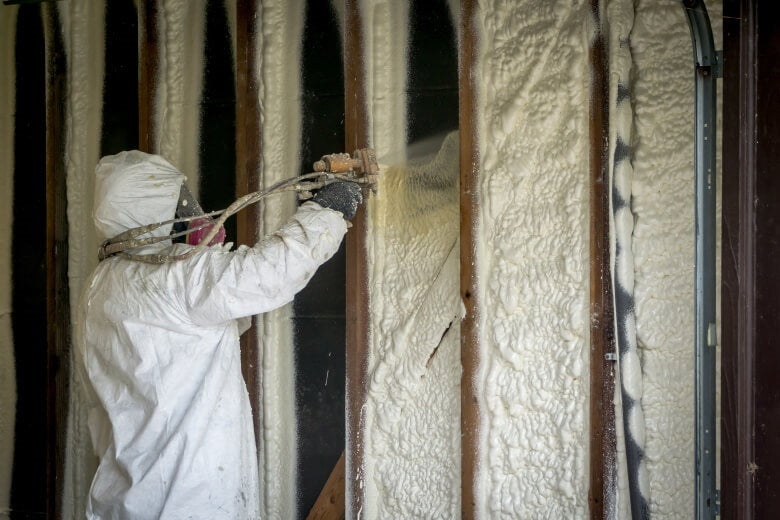Choosing the right insulation for homes is tough. Homeowners must consider energy efficiency, cost, and safety. In recent times, foam insulation, especially spray foam, has become popular. But worries about its effect on health have also increased. This guide from VB Insulation looks into the safety of foam insulation, the possible health risks, and eco-friendly options.
So, is foam insulation safe for health? Many homeowners are asking this because of possible off-gassing issues. We will explore the facts and new research. This will help you choose the best insulation for your home with confidence.
Read More: Which Type of Spray Foam Insulation is Best?
Key Takeaways
- Foam insulation, especially spray foam, is worrying due to off-gassing and being around dangerous chemicals.
- The effects of being around chemicals like formaldehyde and isocyanates in your home are still being studied.
- Good installation practices, like proper ventilation and wearing protective gear, can lower the risks of using foam insulation.
- Eco-friendly and non-toxic insulation alternatives, such as cellulose, mineral wool, and recycled cotton, are healthier options for families.
- It's vital to balance energy efficiency, cost, and indoor air quality when picking insulation for your house.

Understanding the Types of Foam Insulation
VB Insulation explains that foam insulation comes in many types, each with unique uses. The two main kinds are open-cell and closed-cell. Open-cell foam is light and lets air through. Closed-cell foam is denser, and blocks heat better. Rigid foam boards, like those from expanded polystyrene (EPS) or extruded polystyrene (XPS), are also common in buildings.
Spray Foam Insulation: Open-Cell vs Closed-Cell
It is important to know about open-cells and closed-cells in spray foam insulation. Open cells are less dense and allow some air to pass, making them cheaper. Closed cells spray foam are denser, offering great insulation and strength. The choice depends on the building's needs.
Read More: Closed Cell vs Open Cell Foam
Rigid Foam Insulation Boards
VB Insulation also offers rigid foam boards made from EPS or XPS. These boards are suitable for walls, roofs, and other applications. They help keep heat in, making buildings more energy efficient.
Potential Health Risks of Foam Insulation
Spray foam insulation has become very popular lately. Yet, it raises some health worries. This insulation can release chemicals into the air, like volatile organic compounds (VOCs). These may hurt the air quality and people's health. Some of these chemicals are known to cause breathing issues and skin problems.
Off-gassing and Indoor Air Quality Concerns
Off-gassing from foam insulation affects a home's air quality. It releases harmful chemicals into the air. This might be especially bad for those with breathing problems or allergies. Although we know they're not good for us, we're still learning about the lasting effects. This makes us question how safe foam insulation really is for our health.
Exposure to Isocyanates and Other Chemicals
Being around the chemicals in foam insulation is also risky. Isocyanates can lead to breathing problems and skin issues. These dangers are real for both the people who put in the insulation and those who live in the home. So, using foam insulation does come with some risks to our health.
Is foam insulation safe for health?
Many people now wonder if foam insulation is safe. It's great for keeping heat in and air out. However, the chemicals it releases and the health risks it brings must be addressed. We're still trying to figure out the full health effects over time. Because of this, people are looking for safer insulation options, ones that don't harm our health.
Read More: Is Spray Foam Insulation Safe?

Safer Installation Practices for Foam Insulation
Foam insulation can pose health risks if not handled correctly. At VB Insulation, we focus on safe installation. We strictly follow safety regulations to protect our customers and workers.
Proper Ventilation and Air Circulation
Good ventilation requirements and air movement are key. They help lower risks from toxic emissions and off-gassing emissions. Our procedures ensure proper airflow. This helps disperse any chemical exposure during the job.
Protective Equipment for Installers
Keeping our installers safe is crucial at VB Insulation. They wear the right personal protective equipment (PPE), including respirators and protective gear, to guard against exposure to hazardous substances. Through PPE, we secure our installers' insulation safety. They're equipped to do their jobs with spray foam insulation safety in mind.
Read More: Is it safe to be in the house during spray foam insulation?
Eco-Friendly and Non-Toxic Insulation Alternatives
If you worry about the impact of foam insulation on health and the environment, VB Insulation offers eco-friendly options. Their green insulation choices focus on energy savings and clean indoor air.
Cellulose Insulation
Cellulose insulation is made from old paper. It's treated to resist fire and doesn't produce harmful gases. For those looking for insulation that's kind to both health and the planet, this is a great pick.
Mineral Wool Insulation
Mineral wool comes from rock and slag. It's a green choice that's better for the environment than foam. It keeps your home cozy and quiet without risking your health.
Recycled Cotton Insulation
Recycled cotton insulation uses old textile fibers. It's a green, safe option for insulating your house. This choice is perfect for those who want eco-friendly buildings.
VB Insulation's materials match foam's abilities while keeping your indoor air fresh. Choosing these eco-friendly options means making a smart choice for your loved ones and the planet.
Read More: Spray Foam Insulation Cost Per sq ft
Conclusion
The debate over foam insulation safety is ongoing, and many are worried about its risks. Although foam insulation, like spray foam insulation, helps with thermal sealing and air sealing, it comes with some downsides. These include the release of chemicals over time, dealing with dangerous materials, and potential health risks years down the line. This is important for those who care about their family's well-being.
It's beneficial to know about different foam insulation types, such as open-cell and closed-cell foam. Learning about eco-friendly options is also key. These insights help homeowners choose what's best for their family and the environment. VB Insulation suggests looking into green building and energy-efficient methods. These choices focus on indoor air quality and lessen the health risks of foam insulation. They tackle issues like off-gassing from spray foam insulation, foam insulation and allergies, and the use of flame retardants in insulation foam.
With more people understanding the benefits of sustainable building practices, there's a growing need for safe and eco-friendly insulation. This trend is likely to boost new, safer solutions in the insulation sector. VB Insulation is dedicated to helping homeowners through this change. They offer the details and support needed for wise home insulation choices. They aim to balance the importance of energy efficiency and environmental impact with family health and safety.
FAQ
Is foam insulation safe for health?
Foam insulation safety is still being debated and researched. It can release chemicals like formaldehyde and isocyanates, which may lead to breathing and skin problems. Installing it right, getting fresh air, and wearing protection can reduce these risks. Yet, the full effect of foam insulation on health has to be fully discovered.
What are the health risks of spray foam insulation?
Spray foam insulation, both open and closed cells, can cause health problems. It can release VOCs and chemicals into the home, harming the air you breathe and possibly damaging your lungs. Given these risks, consider more planet-friendly insulation options.
Is formaldehyde present in foam insulation?
Yes, some foam insulation types, especially spray foam, might have formaldehyde and VOCs. These could leak out and affect your breathing and skin. To protect your health, check the ingredients of your insulation. Try to pick items that are friendly both to your family and our planet.
What are the alternatives to toxic foam insulation?
Many safe and eco-friendlier insulation options are out there, for example: - Cellulose insulation, which is made from old paper and trained to resist fire - Mineral wool, crafted from rocks and slag - Recycled cotton insulation, composed of reused textile fibers These choices work well for keeping your home comfy while being safer for your health and the earth.
How can I ensure the safe installation of foam insulation?
For a safe foam insulation setup, here are key tips to follow: - Keep the area well-ventilated to cut down on inhaling harmful emissions - Use the right safety gear, like masks and special clothes, to protect yourself - Always stick to the safety rules and the advice from the product's maker to steer clear of health or safety issues




